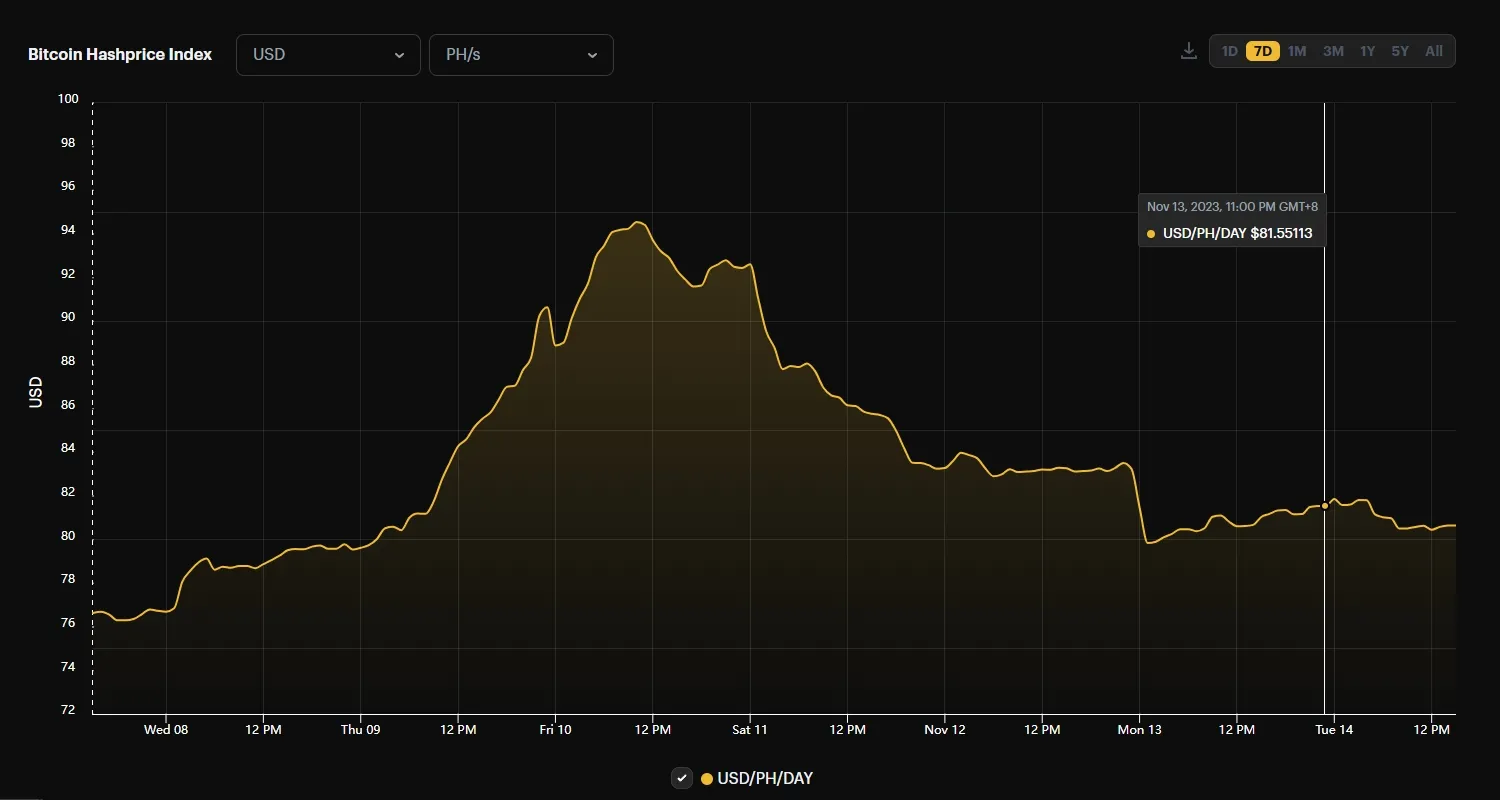Introduction
In the intricate tapestry of the cryptocurrency world, Bitcoin’s hashrate stands as a testament to the relentless pursuit of decentralized security and efficiency. As of November 13, 2023, this metric not only continues to be a pivotal indicator of the health and robustness of the Bitcoin network but also serves as a beacon, guiding the ever-evolving landscape of digital mining.
The hashrate, in its essence, is an estimate of the total computational power being used to mine and process Bitcoin transactions. It’s a dynamic testament to the collective effort of miners around the globe who compete for the privilege of adding new blocks to the blockchain. This competition is not just a race for rewards but a cornerstone of the network’s security, making Bitcoin resistant to attacks and fraud.
Recent trends, as observed on the Hashrate Index, reveal a fascinating narrative. The 7-day Simple Moving Average (SMA), considered the industry standard for hashrate reporting, shows a nuanced yet telling picture of the network’s state. As of this date, the hashrate hovers around the 470 EH/s mark, a figure that speaks volumes about the current state of Bitcoin mining.
This number, however, is not just a static figure. It’s the culmination of various factors, including technological advancements in mining hardware, global energy prices, and the ever-changing landscape of regulatory frameworks. Each of these elements plays a crucial role in shaping the hashrate, making it a barometer for the economic and technological health of the Bitcoin ecosystem.
As we delve deeper into the intricacies of Bitcoin’s hashrate, it’s essential to remember that this metric is more than just a number. It’s a reflection of human ingenuity, economic trends, and the relentless pursuit of a decentralized future. The hashrate is not just about how many hashes per second the network can produce; it’s about the people, the machines, and the collective effort that makes Bitcoin what it is today.
In this article, we will explore the various dimensions of Bitcoin’s hashrate, unraveling the layers that make it a critical component of the cryptocurrency world. From its impact on mining profitability to its implications for network security, the journey through Bitcoin’s hashrate is a journey through the heart of the blockchain revolution.
Understanding Bitcoin’s Hashrate
In the realm of Bitcoin, the hashrate is more than just a technical term; it’s the heartbeat of the network’s security and efficiency. As we delve into the intricacies of Bitcoin’s hashrate, it’s essential to grasp its definition and the pivotal role it plays in the mining ecosystem.

The Essence of Bitcoin’s Hashrate
Bitcoin’s hashrate is a measure of the computational power per second used in mining and processing transactions on the Bitcoin network. It’s an aggregate estimate, representing the sum of all the mining power contributed by miners globally. This metric is crucial as it directly correlates to the strength and security of the network. The higher the hashrate, the more difficult it is for a single entity to orchestrate a 51% attack, thereby maintaining the integrity and trust in the Bitcoin blockchain.
The hashrate is not a static figure; it’s a dynamic representation of a multitude of factors, including the number of miners, the efficiency of mining equipment, and the overall health of the mining ecosystem. As of November 13, 2023, the 7-day Simple Moving Average (SMA) of Bitcoin’s hashrate, a standard in industry reporting, provides a clear picture of the network’s current computational power, standing robustly around the 470 EH/s mark.
Interplay Between Hashrate, Mining Difficulty, and Network Security
The relationship between Bitcoin’s hashrate, mining difficulty, and network security is a delicate balance, a symphony of interdependent elements that ensure the smooth functioning of the network. Mining difficulty, an automatic adjustment mechanism within the Bitcoin protocol, is designed to maintain a consistent block time, regardless of the total mining power at any given moment.
As the hashrate increases, with more miners and more powerful equipment joining the network, the mining difficulty adjusts upwards to ensure that the time taken to find a new block remains roughly the same. This adjustment is crucial for maintaining the network’s stability and predictable issuance of new bitcoins. Conversely, if the hashrate drops, the difficulty decreases, keeping the block production rate steady.
This dynamic adjustment of difficulty in response to changes in the hashrate is a cornerstone of Bitcoin’s security. It ensures that no single miner or group of miners can easily dominate the block production process, thus preserving the decentralized nature of the network. The higher the hashrate, the more secure the network is, as it becomes exponentially more challenging and resource-intensive to attempt malicious attacks.
Recent Trends in Bitcoin’s Hashrate
In the ever-evolving landscape of Bitcoin, the hashrate serves as a critical indicator of the network’s health and robustness. As of November 13, 2023, a deep dive into the current state of Bitcoin’s hashrate not only reveals its present status but also allows us to chart its journey over time, offering insights into the resilience and adaptability of the network.
The Current State of Bitcoin’s Hashrate
As we stand in late 2023, the Bitcoin network’s hashrate presents a picture of robust health and technological advancement. The data from Hashrate Index shows a hashrate hovering around 470 EH/s, a testament to the increasing computational power and efficiency of the mining network. This figure is not just a mere statistic; it represents the culmination of continuous innovation in mining technology, the growing global distribution of miners, and the overall increasing interest and investment in Bitcoin mining.
The current hashrate indicates a network that is more secure and resilient than ever before. With such a high level of computational power distributed across the globe, the Bitcoin network stands as a fortress against potential attacks, ensuring the integrity and trustworthiness of its transactions and ledger.
Historical Comparison and Growth Analysis
To appreciate the significance of the current hashrate, one must look back at the historical data. Over the years, Bitcoin’s hashrate has seen a remarkable trajectory of growth. From the early days of Bitcoin, where mining was a pursuit for hobbyists using basic computers, to the present day’s sophisticated and specialized mining rigs, the hashrate has grown exponentially.
This growth can be attributed to several factors, including the increasing value of Bitcoin, which has incentivized more participants to join the mining network, and technological advancements in mining hardware, making it more efficient and powerful. Additionally, the geographical diversification of mining operations has contributed to a more stable and decentralized network.
Comparing the current hashrate to that of previous years, we see not just an increase in numbers but also an evolution in the Bitcoin ecosystem. The network’s ability to adapt to various challenges, such as regulatory changes, market fluctuations, and technological advancements, is clearly reflected in the steady upward trend of the hashrate.
Factors Influencing Bitcoin’s Hashrate
In the intricate and ever-evolving world of Bitcoin, the hashrate stands as a critical barometer of the network’s health and vitality. This hashrate, a measure of the computational power dedicated to mining and processing transactions, is influenced by a confluence of diverse factors. Understanding these elements is essential to grasp the dynamics of Bitcoin mining and its future trajectory.
The Interplay of Economics, Technology, and Regulation
- Changes in Bitcoin’s Price: The price of Bitcoin is a primary driver of the network’s hashrate. As the value of Bitcoin escalates, it enhances the profitability of mining, attracting more participants to the network. This influx of miners increases the overall computational power, thereby elevating the hashrate. Conversely, a decline in Bitcoin’s price can lead to reduced mining profitability, prompting miners to exit the network, which results in a decreased hashrate. This direct correlation between Bitcoin’s price and its hashrate underscores the economic incentives that underpin the mining ecosystem.
- Technological Advancements in Mining Hardware:The evolution of mining hardware is a pivotal factor influencing Bitcoin’s hashrate. The transition from basic CPUs to advanced ASICs (Application-Specific Integrated Circuits) has markedly increased the efficiency and power of mining operations. These technological advancements have led to a surge in the hashrate, as newer, more powerful machines contribute greater computational power to the network. The continuous innovation in mining technology not only boosts the hashrate but also fortifies the overall security and robustness of the Bitcoin network.
- Global Energy Prices and Mining Profitability:Energy costs are a critical component of mining profitability. The relationship between global energy prices and Bitcoin’s hashrate is intricate. High energy prices can diminish the profitability of mining, especially for operations with less efficient hardware or in regions with higher energy costs. This can lead to a reduction in mining activity and a consequent decrease in the hashrate. Conversely, lower energy prices can boost mining profitability, encouraging more mining activity and thus increasing the hashrate. The global energy market, therefore, plays a significant role in shaping the hashrate landscape.
- Regulatory Changes and Their Impact:Regulatory changes in various countries have a profound impact on Bitcoin’s hashrate. Regulations can either foster a supportive environment for mining or create restrictive conditions that hinder mining activities. For instance, regulatory crackdowns on mining in certain regions can lead to a significant drop in the hashrate, as miners either shut down or relocate to more favorable jurisdictions. Conversely, supportive regulatory environments can attract miners, contributing to an increase in the hashrate. The regulatory landscape is thus a crucial factor in the global distribution and intensity of Bitcoin mining activities.
Hashrate and Mining Profitability
In the intricate world of Bitcoin mining, the correlation between hashrate and mining profitability is a subject of paramount importance. This relationship is not only central to the decisions of individual miners but also to the broader dynamics of the Bitcoin network. Let’s delve into how this correlation plays out and its impact on popular mining models.
The Correlation: Hashrate and Profitability
The hashrate of the Bitcoin network, representing the total computational power used for mining, is intrinsically linked to mining profitability. A higher hashrate generally indicates a more competitive mining environment. As more miners join the network or existing miners upgrade their equipment, the hashrate increases. However, this also means that the rewards for mining a block are distributed among a larger pool of miners, potentially reducing individual profitability.
Conversely, a lower hashrate suggests less competition, which could mean higher profitability for those who continue to mine. However, this is often balanced by the network’s difficulty adjustment algorithm, designed to maintain a consistent block time regardless of the total mining power. This dynamic interplay ensures that the profitability of mining is not solely dependent on the hashrate but is also influenced by factors such as Bitcoin’s price, energy costs, and the efficiency of mining hardware.
Impact on Popular Mining Models
The current state of the Bitcoin network’s hashrate has a direct impact on the earnings from popular mining models like the S19j Pro, S19k Pro, and S19 XP. These advanced mining rigs, known for their efficiency and high output, are at the forefront of the mining industry. However, their profitability is not immune to the changes in the network’s hashrate.
For instance, in a high hashrate environment, even these efficient models may see a decrease in individual earnings due to the increased competition. Conversely, in scenarios where the hashrate drops, these models, due to their higher efficiency, might enjoy a temporary boost in profitability. It’s important to note that the profitability of these models is also contingent on other factors like the current Bitcoin price, operational costs, and the overall state of the market.
Bitcoin Mining Difficulty and Network Adjustments
In the realm of Bitcoin mining, understanding the intricacies of mining difficulty and network adjustments is crucial. These elements are not just technical aspects of the blockchain but are fundamental to the functioning and security of the Bitcoin network. Let’s explore the recent changes in Bitcoin mining difficulty and how the network responds to fluctuations in hashrate.
Recent Changes in Bitcoin Mining Difficulty
Bitcoin mining difficulty is a measure that reflects how hard it is to mine a new block. The difficulty adjusts approximately every two weeks, ensuring that the time it takes to mine a block remains consistent, around ten minutes. This adjustment is crucial for maintaining the blockchain’s regular block time despite the fluctuating hashrate.
Recently, the Bitcoin network has experienced significant changes in mining difficulty. These adjustments are a direct response to the changes in the network’s hashrate. For instance, an increase in the hashrate, due to more miners joining the network or existing miners upgrading their equipment, leads to a higher mining difficulty. This is because more computational power in the network means blocks could be mined faster than the intended ten-minute interval. To counter this, the difficulty increases, making it harder to mine a new block and thus balancing the block production rate.
Conversely, if the hashrate decreases, perhaps due to miners leaving the network or a drop in mining profitability, the difficulty adjusts downward. This makes it easier to mine new blocks, compensating for the reduced computational power and maintaining the regular pace of block production.
The Network’s Response to Hashrate Changes
The Bitcoin network’s ability to adjust mining difficulty in response to changes in the hashrate is a testament to its robust and adaptive design. This mechanism ensures that the network remains secure and functional regardless of external factors such as fluctuations in Bitcoin’s price, changes in global energy costs, or regulatory shifts that might impact mining activities.
The difficulty adjustment algorithm is designed to keep the blockchain stable and predictable. It’s a critical feature that not only maintains the integrity of the blockchain but also ensures that mining remains feasible and profitable for participants. This adaptability is one of the key reasons why Bitcoin has remained resilient and continues to thrive despite the various challenges it faces.
The Future Outlook of Bitcoin’s Hashrate
As we look towards the future of Bitcoin’s hashrate, it’s essential to consider the trends and technological advancements that are likely to shape this crucial aspect of the Bitcoin network. The hashrate, a measure of the computational power dedicated to mining Bitcoin, is not just a technical statistic but a reflection of the network’s health and security. Let’s explore the potential future trends and the impact of technological advancements on Bitcoin’s hashrate.
Predicting Future Trends in Bitcoin’s Hashrate
The future of Bitcoin’s hashrate is influenced by several factors, including technological advancements, economic conditions, and regulatory environments. One key trend to watch is the continuous improvement in mining hardware. As new, more efficient mining rigs are developed, they are likely to contribute to an increase in the overall hashrate. Additionally, the price of Bitcoin plays a significant role in influencing the hashrate. Higher Bitcoin prices can make mining more profitable, attracting more miners to the network and thus increasing the hashrate.
Another factor to consider is the global regulatory landscape. Changes in regulations can either encourage or discourage mining activities in different regions, impacting the distribution and intensity of mining efforts. Furthermore, the energy costs associated with mining are also crucial. As miners seek more sustainable and cost-effective energy sources, this could lead to a more geographically diverse mining landscape, potentially affecting the hashrate.
Technological Advancements and Their Impact
Technological advancements in mining hardware are expected to have a profound impact on Bitcoin’s hashrate. The development of more efficient ASIC miners, for example, could significantly increase the hashrate by providing more computational power with lower energy consumption. This would not only make mining more profitable but also more environmentally sustainable.
In addition to hardware improvements, advancements in mining software and algorithms could also play a role. These could include more efficient ways of processing transactions or new methods of optimizing mining operations. As these technologies evolve, they could lead to a more efficient and robust Bitcoin network, reflected in a higher and more stable hashrate.
Conclusion
As we encapsulate the insights gathered from our exploration of Bitcoin’s hashrate, it becomes evident that this metric is not just a mere number but a profound indicator of the health, security, and future direction of the Bitcoin network. The hashrate, a testament to the computational power dedicated to Bitcoin mining, offers a window into the intricate dynamics of the cryptocurrency market. Let’s summarize the key points and reflect on the implications of the current state of Bitcoin’s hashrate for the future of Bitcoin mining and the cryptocurrency market as a whole.



